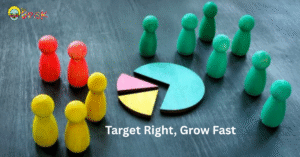One of the most difficult tasks you’ll face as a business owner is choosing how to properly reach your target audience using the correct advertising methods.
There is no denying that one of today’s most critical duties for marketers is to communicate the proper message about their brand to the right crowd.
In this blog post, let’s delve into that discussion by discussing what exactly audience targeting is and how to do it correctly.
Audience Targeting: An Overview
So, what exactly is audience targeting? The capacity to divide your whole market of potential customers into divisions based on various factors such as digital behavioral traits, demographics, preferences, and purpose is defined as audience targeting.
Audience targeting allows you to create more tailored and optimal experiences depending on your customers’ requirements and interests.
You’ll be more likely to reach people who are ready to buy your services if you use audience targeting. It also helps move potential consumers through the sales cycle by reducing the likelihood of wasting ad budget on uninterested viewers.
Importance of Audience Targeting
As it’s hard to reach everybody at once, focusing on a core target might help you design a more effective marketing approach. It assists your business in developing a message plan that speaks directly to the kind of clients that are more likely to become customers.
Targeting specific audiences has various advantages for marketers. The most essential thing is not to keep showing your ads to those who aren’t interested in your products or services, while also making them more relevant and effective to boost your return on investment.
The biggest and most essential result of targeting the proper audience is that you will receive solid results – clients who are ready to purchase your advertising items.
It also allows campaign managers to determine which demographics are interacting and eventually turn to their advertisers’ commercials.
Campaign managers may use this data to further improve their marketers’ efforts by assigning resources to the appropriate audience categories.
Using contextual ads, you can use audience targeting to reach out to existing consumers and entice them to return to your websites and items.
How to Do It Right?
You have to spend time looking at data from user encounters, reviewing existing purchasers and buying trends, and improving as new information comes to light to define your target audience. The following procedures can help you discover your target audience:
1. Conduct Client Surveys and Evaluate Your Current Customers
One of the best ways to determine who your target client is is to examine your present consumer demography. What is their age, where do they live, and what do they like?
Engaging with your customers on social media or sending customer surveys is an excellent way to learn more about this.
2. Do Market Research to Determine Trends in the Industry
According to The Brisk, conducting market research will allow you to understand your buyers more thoroughly.
By knowing your customers’ concerns, problems, and intended solutions, you can properly create your product or service to genuinely connect with them.
Market research also provides insight into a broad range of commercial concerns.
3. Identify Who Isn’t a Part of Your Target Audience
Your own client database may potentially be a goldmine of information. You cannot expect that your entire consumer demographics will fit your target group.
However, knowing who is already buying from you might help you determine who is most likely interested in your products.
Try to be as thorough as possible in establishing who your target is and who it isn’t.
4. Make use of Google Analytics
Google Analytics is an amazing and free way to learn about the demographics of your target audience.
You may review your viewer’s age, location, and device (mobile or desktop), as well as other important statistics relating to these metrics.
You can see how much time each age group and gender spends on your site, as well as which pages they visit the most and least.
This data can be utilized to get key insights such as which channels your target audience is utilizing or what type of content they are most interested in, allowing you to make better data-based decisions throughout the marketing strategic plan.
5. Look Into Your Competitors
If there are companies that provide a similar product to you and have been doing that for a long time, they will already have a good understanding of your target market.
Check their social media accounts, the types of people that regularly like their postings, and the type of content that receives a lot of attention.
Additionally, see if you can identify the parts that are underperforming. Consider ways to improve it. Using this newly found data with what you already know about your present clients may allow you to expand your target group to include characteristics you hadn’t originally thought of!
6. Post Relevant Stuff on Your Social Media
And finally, your content should feel relatable to your target audience. If you see that some forms of content connect with your audience well, keep that in mind when you plan your next marketing strategy.
Use social media to provide helpful content by publishing about discounts, future releases, and re-posting positive reviews.
Final Thoughts
Understanding your target audience is simply the start of a good marketing strategy, but it’s not enough.
To reach your target demographic, you’ll need to devise a variety of marketing strategies.
So, figure out who your company serves and whether they should engage with you. Note that testing is the only option to truly learn whom you can target.
After you have identified your target market, make sure your items or services meet their requirements.
Then, establish your target audience, the exact demographic to whom you intend to send your marketing approach.
Just doing the legwork to define your target demographic ahead of time can help you fine-tune your brand’s voice and marketing plan.




No Comments